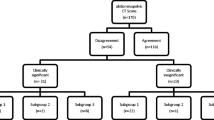Abstract
Objective
To assess the discrepancy rate for the interpretation of abdominal and pelvic computed tomography (CT) examinations among experienced radiologists.
Methods
Ninety abdominal and pelvic CT examinations reported by three experienced radiologists who specialize in abdominal imaging were randomly selected from the radiological database. The same radiologists, blinded to previous interpretation, were asked to re-interpret 60 examinations: 30 of their previous interpretations and 30 interpreted by others. All reports were assessed for the degree of discrepancy between initial and repeat interpretations according to a three-level scoring system: no discrepancy, minor, or major discrepancy. Inter- and intrareader discrepancy rates and causes were evaluated.
Results
CT examinations included in the investigation were performed on 90 patients (43 men, mean age 59 years, SD 14, range 19–88) for the following indications: follow-up/evaluation of malignancy (69/90, 77%), pancreatitis (5/90, 6%), urinary tract stone (4/90, 4%) or other (12/90, 13%). Interobserver and intraobserver major discrepancy rates were 26 and 32%, respectively. Major discrepancies were due to missed findings, different opinions regarding interval change of clinically significant findings, and the presence of recommendation.
Conclusions
Major discrepancy of between 26 and 32% was observed in the interpretation of abdominal and pelvic CT examinations.

Similar content being viewed by others
References
Kohn LT, Corrigan JM, Donaldson MS (2000) To err is human: building a safer health system. National Academy Press, Washington, DC
Weingart SN, Wilson RM, Gibberd RW, Harrison B (2000) Epidemiology of medical error. BMJ 320:774–777
Jackson VP, Cushing T, Abujudeh HH et al (2009) RADPEER scoring white paper. J Am Coll Radiol 6:21–25
FitzGerald R (2005) Radiological error: analysis, standard setting, targeted instruction and teamworking. Eur Radiol 15:1760–1767
Goddard P, Leslie A, Jones A, Wakeley C, Kabala J (2001) Error in radiology. Br J Radiol 74:949–951
Berlin L (2007) Accuracy of diagnostic procedures: has it improved over the past five decades? AJR Am J Roentgenol 188:1173–1178
Armato SG 3rd, Roberts RY, Kocherginsky M et al (2009) Assessment of radiologist performance in the detection of lung nodules: dependence on the definition of “truth”. Acad Radiol 16:28–38
Melvin C, Bodley R, Booth A, Meagher T, Record C, Savage P (2004) Managing errors in radiology: a working model. Clin Radiol 59:841–845
Robinson PJ, Wilson D, Coral A, Murphy A, Verow P (1999) Variation between experienced observers in the interpretation of accident and emergency radiographs. Br J Radiol 72:323–330
Garland LH (1959) Studies on the accuracy of diagnostic procedures. Am J Roentgenol Radium Ther Nucl Med 82:25–38
Leslie A, Jones AJ, Goddard PR (2000) The influence of clinical information on the reporting of CT by radiologists. Br J Radiol 73:1052–1055
Soffa DJ, Lewis RS, Sunshine JH, Bhargavan M (2004) Disagreement in interpretation: a method for the development of benchmarks for quality assurance in imaging. J Am Coll Radiol 1:212–217
Wong WS, Roubal I, Jackson DB, Paik WN, Wong VK (2005) Outsourced teleradiology imaging services: an analysis of discordant interpretation in 124,870 cases. J Am Coll Radiol 2:478–484
Platts-Mills TF, Hendey GW, Ferguson B (2008) Teleradiology interpretations of emergency department computed tomography scans. J Emerg Med. doi:10.1016/j.jemermed.2008.01.015
Tieng N, Grinberg D, Li SF (2007) Discrepancies in interpretation of ED body computed tomographic scans by radiology residents. Am J Emerg Med 25:45–48
Dang PA, Kalra MK, Blake MA, Schultz TJ, Halpern EF, Dreyer KJ (2008) Extraction of recommendation features in radiology with natural language processing: exploratory study. AJR Am J Roentgenol 191:313–320
European Organisation for Research and Treatment of Cancer (2009) Response evaluation criteria in solid tumors - RECIST. Available at URL: http://www.eortc.be/recist/ Accessed December 4, 2009
Funding Information
None.
Author information
Authors and Affiliations
Corresponding author
Rights and permissions
About this article
Cite this article
Abujudeh, H.H., Boland, G.W., Kaewlai, R. et al. Abdominal and pelvic computed tomography (CT) interpretation: discrepancy rates among experienced radiologists. Eur Radiol 20, 1952–1957 (2010). https://doi.org/10.1007/s00330-010-1763-1
Received:
Revised:
Accepted:
Published:
Issue Date:
DOI: https://doi.org/10.1007/s00330-010-1763-1




